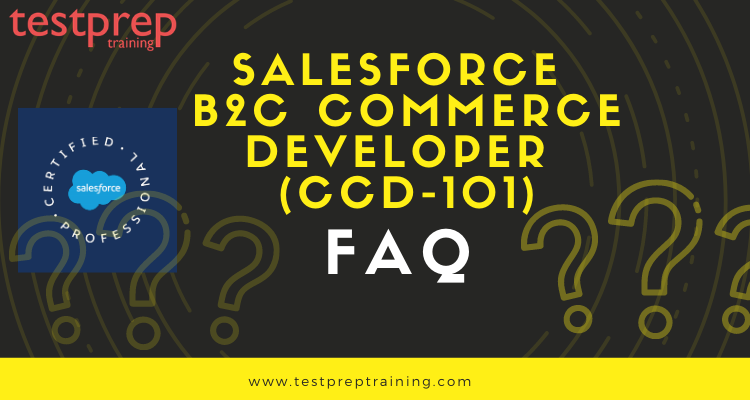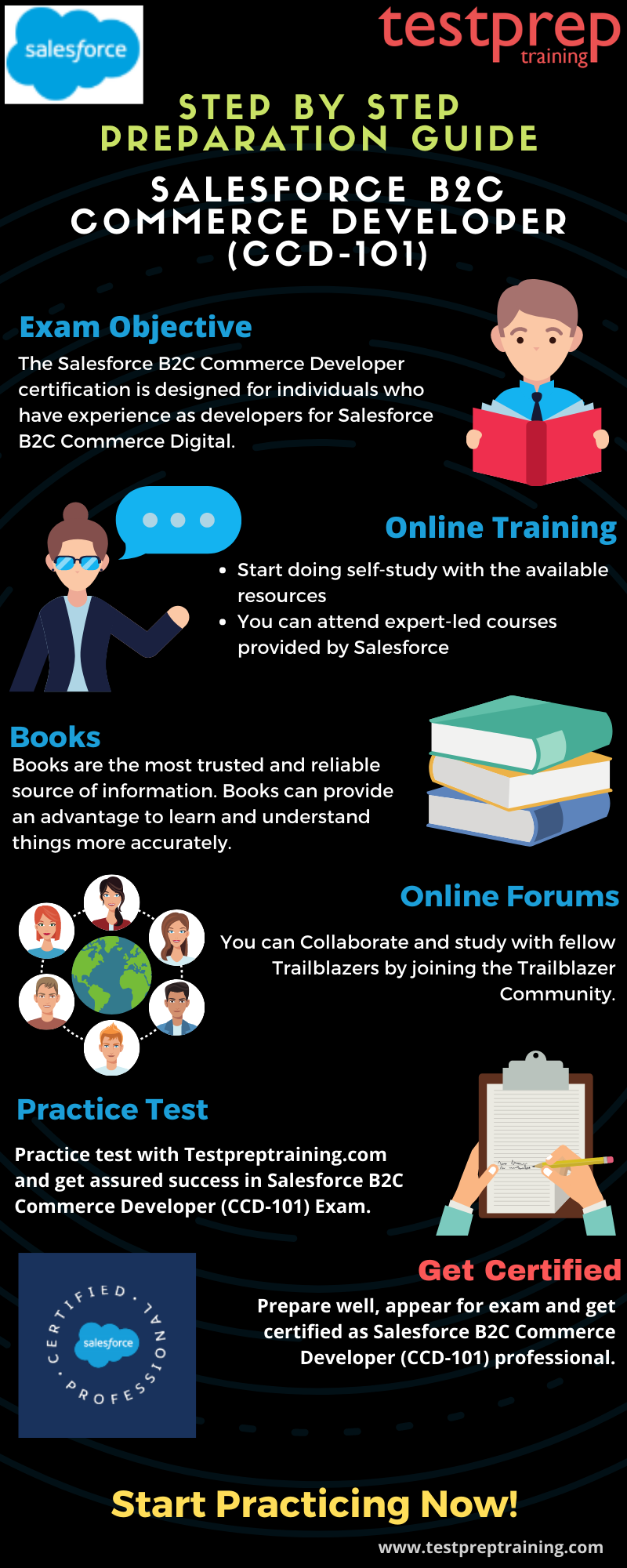Salesforce B2C Commerce Developer (CCD-101)

The Salesforce B2C Commerce Developer exam (CCD-101) course focuses on building the fundamentals of the core programming concepts, relevant files, and scripting language for Salesforce B2C Commerce. The Salesforce B2C Commerce Developer certification is designed for individuals who have experience as developers for Salesforce B2C Commerce Digital.
Benefits from this Course
This course targets the developers who want to demonstrate their knowledge and skills in using B2C Commerce to develop an eCommerce solution, such as:
- Implementing and using Storefront Reference Architecture (SFRA).
- Creating cartridges to add reusable functionality to a site.
- Creating, using, and modifying JavaScript controllers to add business logic to a site.
- Creating reusable code using ISML templates.
- Using Content Slots or Page Designer to improve the appearance and flexibility of a site.
- Using the Forms Framework to control the validation, rendering, and storing of consumer-centered values.
- Using the B2C Commerce APIs to modify business logic in the site.
- Using jobs to create batch processes on system or custom objects.
- Using Open Commerce API (OCAPI) to customize business logic.
- Integrating with third-party systems with B2C Commerce asynchronous and synchronous methods as appropriate for the business need.
- Creating code and configuring sites to ensure sites can scale while continuing to perform optimally.
- Using appropriate tools to troubleshoot issues with code or configuration of a site, as well as optimize the site performance.
Eligibility
It is recommended that a Salesforce B2C Commerce Developer should have, One year of developer experience + three to six months of experience in a B2C Commerce Developer role.
Intended Job Roles
The job roles of a Salesforce Certified B2C Commerce Developer candidate may include:
- Front End Developer
- Full-Stack Developer
- Software Developer
- Java or JavaScript Programmer
- Web Application Developer
- Support Engineer
Salesforce B2C Commerce Developer Interview Questions
Now, Let us look at some Salesforce B2C Commerce Developer Interview Questions and see what types and variations can be expected.

Exam Details
The Salesforce B2C Commerce Developer Exam Question are in multiple-choice, multiple-select, or matching questions format. You must have complete knowledge of the exam before proceeding with the preparations. Here are the exam details:
- Exam Name: Salesforce B2C Commerce Developer (CCD-101)
- Content: 60 multiple-choice, multiple-select, or matching questions
- Time allotted to complete the exam: 105 minutes
- Passing score: 65%
Scheduling the Exam
The Salesforce (CCD-101) exams can be scheduled either at an onsite proctored center or online with a virtual proctor through the salesforce testing partner, Kryterion Global Testing Solutions.

For more details related to exam policies visit: Salesforce B2C Commerce Developer (CCD-101) FAQ
Exam Outline
The Exam outline for this exam is designed in the following manner:

B2C Commerce Setup: 11%
- Given a sandbox environment, configure an IDE to use WebDAV to deploy cartridges to the correct version directories. (Salesforce Documentation: Upload and Configure Cartridges)
- Given a sandbox instance and data import files, import files using the Business Manager Import/Export modules. (Salesforce Documentation: Explore Business Manager Import and Export)
- Given the code for a storefront site, add the correct sequence of cartridge names to the provided cartridge path.
- Given a sandbox environment, use the Business Manager to add a new site to the instance, configuring the default currency and taxation type according to business requirements. (Salesforce Documentation: Get Started with Commerce Cloud Business Manager)
- Given a recently created B2C site, assign the storefront data configurations according to business requirements. (Salesforce Documentation: Business Manager Settings)
Work With a B2C Site: 12%
- Given a Business Manager task, work with the product data model to manage products and a product search model, their categorization, and associated inventory and price books. (Salesforce Documentation: B2C Commerce Product Data)
- Given a configuration for tasks, such as payment and shipping information, use Business Manager to complete storefront orders.
- Given a configuration task, use Business Manager to work with Content Assets, Page Designer, Content Slots, and Content Folders. (Salesforce Documentation: Document Content Assets and Content Slots)
Data Management Using Business Manager Usage: 24%
- Given a business requirement, modify site search preferences and settings to enable searching for a specified term or product attribute. (Salesforce Documentation: Configure Search Settings in Salesforce Classic)
- Given a business requirement, create and configure a new search refinement and sorting definition that can be used on the storefront. (Salesforce Documentation: Business Manager Settings)
- Given a debugging requirement or code, configure the logging categories and access the logs in the Business Manager. (Salesforce Documentation: Monitor Setup Changes with Setup Audit Trail)
- Given business requirements, extend the storefront to expose a new attribute on an existing system object type. (Salesforce Documentation: Client’s Data Model)
- Given a business need to store custom data, determine if a custom object is needed, and create and configure as required. (Salesforce Documentation: Considerations for Creating Custom Objects)
- Given a performance issue and data, use relevant tools to inspect code performance and determine and implement solutions (cache configuration, profilers, etc) to improve performance. (Salesforce Documentation: A Guide to Application Performance Profiling in Force.com)
- Given a specification and a sandbox instance, configure OCAPI permissions for Data and Shop APIs.
- Given a service configuration, recognize how they are applicable to the development process. (Salesforce Documentation: Transform the app development process to deliver value to the business faster)
Application Development: 53%
- Given a development task, code ISML templates that use functions such as local include, remote include, components, and other ISML tags.
- Use debugging best practices and techniques to troubleshoot scripts and controllers and verify outcomes. (Salesforce Documentation: Debug and Run Diagnostics)
- Given a requirement, create and extend the functionality of a JavaScript controller that leverages models, decorators, factories, or helpers following API best practices and renders a template or returns a JSON response. (Salesforce Documentation: Explore Page and Component Type Controllers, JSON, and Scripts)
- Given a business requirement and design for a new marketing page, develop page types and components to allow a marketer to build a page with the Page Designer tool. (Salesforce Documentation: Explore Pages, Components, and Development Elements)
- Given a requirement to accept, validate, and persist information from a storefront customer, modify the appearance of a form, add validation and CSRF protection, and use bindings to process fields. (Salesforce Documentation: CSRF protection settings)
- Given localization requirements, implement and enhance templates, form definitions, static files, properties files, and persistent object attributes to ensure that pages are displayed in the expected language. (Salesforce Documentation: Set Up and Manage Salesforce Communities)
- Given a logging task and existing configuration, write code that logs non-sensitive data to custom log files with different log levels. (Salesforce Documentation: Set Up Debug Logging)
- Integrate, deploy, and use a service instance based on a given requirement. (Salesforce Documentation: Build Apps Together with Package Development)
- Given a use case, extend functionality or capture an event using hook extension points. (Salesforce Documentation: Extending Lightning Components)
- Given code that violates documented best practices, identify the issues, and modify the code to conform with best practices including performance and scalability. (Salesforce Documentation: Performance test)
- Given a business requirement, use OCAPI Shop and Data APIs to enable interoperability with an external system.
- Given a business requirement to perform a scheduled task, develop jobs, and code job scripts. (Salesforce Documentation: Create Custom Job Steps)
Preparation Guide
The Preparation Guide is meant to provide you a brief outline of the whole exam pathway. This Salesforce Certified B2C Commerce Developer Exam Guide will give you an idea as to how you should get started with the exam preparation. So, make sure to take a look at this guide and kick start your preparation.

Learning Resources
Start your preparation with following set of learning resources:
Salesforce B2C Commerce Developer Training
Salesforce provides candidates with training that helps them to build competence, confidence, and credibility. In this, candidates can choose to learn online at their own pace or they can learn from an accredited instructor built by experts at Salesforce. This will be beneficial for both beginners who are building on existing skills, or who are experienced professionals required knowledge. Salesforce offers two types of training that include:
1.Start doing self-study with the available resources: Salesforce B2C Commerce online documentation
2.You can attend expert-led courses provided by Salesforce:
Join Community
You can Collaborate and study with fellow Trailblazers by joining the Trailblazer Community. The members of this community are both skilled and experienced developers as well as inexperienced learners. So, joining such a community will resolve most of your exam-related problems. These communities are very interactive and updated with new ideas and new development in the market. Therefore, to stay updated and get your queries resolved from experiences members make sure to join this community. Further, you may join communities available on other social media platforms like LinkedIn, Quora, etc.
Books
Books are the most trusted and reliable source of information. Books can provide an advantage to learn and understand things more accurately. For the Salesforce B2C Commerce Developer (CCD-101) exam, there are various books available which you can find online or in libraries.
Exam Practice Tests
Salesforce Certified B2C Commerce Developer Practice Tests have always been the most reliable source of judging the level of preparation. By practicing you will be able to improve your answering skills in a specified timeframe that will result in saving a lot of time in the actual exam. So, make sure to find the best practice test which suits your requirement and start practicing at the earliest. You can also refer testpreptraining practice tests, which are based on actual exam pattern.

